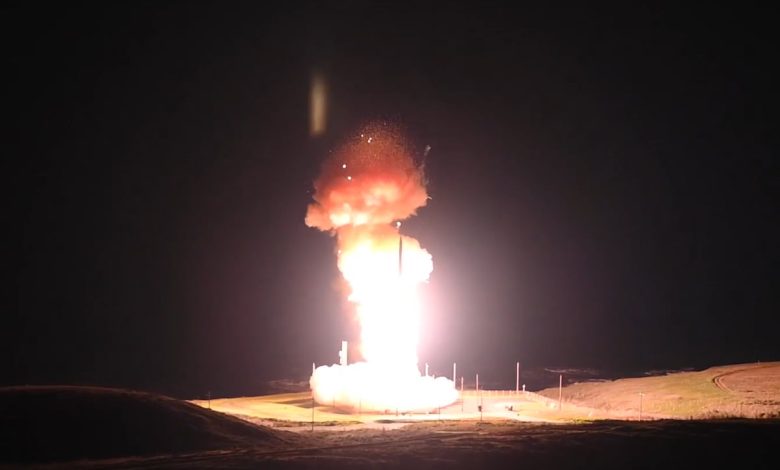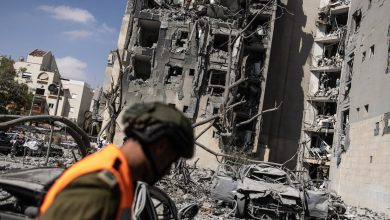Air Force tests unarmed nuclear missile in pre-dawn video

The Air Force conducted a test launch of an unarmed Minuteman III missile early Wednesday to help ensure its land-based nuclear force still operates safely and effectively.
Airmen from Air Force Global Strike Command launched the intercontinental ballistic missile from Vandenberg Space Force Base in California at 1 a.m. Pacific Standard Time, the department said. The Minuteman missile carried no nuclear payload but was instead equipped with a test re-entry vehicle that was designed to transmit readings.
The missile flew about 4,200 miles at speeds of more than 15,000 mph to the Ronald Reagan Ballistic Missile Defense Test Site at the Marshal Islands’ Kwajalein Atoll. Personnel at the test site, which is run by Army Space and Missile Defense Command, collected radar, optical and telemetry data as the missile closed in, to measure how well it worked.
“Today’s Minuteman III test launch is just one of the ways the Department of the Air Force demonstrates the readiness, precision, and professionalism of U.S. nuclear forces,” acting Air Force Secretary Gary Ashworth said. “It also provides confidence in the lethality and effectiveness of the nation’s nuclear deterrence mission.”
The Air Force’s arsenal of roughly 400 Minuteman III ICBMs is a crucial component of the nation’s nuclear triad, along with bombers and submarines that can also carry and deploy nuclear weapons.
The Minuteman III system is more than 50 years old and rapidly approaching the end of its life. The Air Force and Northrop Grumman are working on a replacement for the Minuteman III, the LGM-35A Sentinel, which is intended to start being deployed in the 2030s.
But the ground-based systems for Sentinel — particularly its control infrastructure — proved to be more complicated than the Pentagon originally expected, and anticipated future costs ballooned. This set off alarm bells in the Pentagon and Congress in early 2024, and the program went under an intensive review.
The military ultimately decided last summer Sentinel was too crucial to cancel, and that the Air Force must continue developing it to replace the Minuteman III. But the Pentagon ordered the Air Force to restructure the program and bring those anticipated costs down.
The restructuring of Sentinel will likely delay it several years, Pentagon officials said in 2024, which means the Air Force must continue relying on Minuteman III longer than expected. Andrew Hunter, the Air Force’s then-acquisition chief, said in July 2024 the Air Force will “do what it takes to sustain Minuteman III to meet these warfighter requirements in the interim,” before Sentinel is ready.
Col. Dustin Harmon, commander of the 377th Test and Evaluation Group at Vandenberg that oversaw the test launch, said the data collected from the test “is crucial for maintaining Minuteman III while we pave the way for Sentinel.”
RELATED
“During this test, we collected and analyzed performance and other key data points to evaluate current missile system competencies,” Harmon said. “This allows our team to analyze and report accuracy and reliability for the current system while validating projected missile system improvements.”
This test was in the works for months, the Air Force said, and is the latest in a series of more than 300 other such test launches that the department regularly conducts.
Vandenberg’s Western Range is the main testing ground for Global Strike’s ICBMs. In a video the Air Force released shortly after the test, a silo cover at Vandenberg can be seen sliding open before the test Minuteman launches in a burst of fire and roars into the pre-dawn sky.
The missile was randomly selected from the Air Force’s arsenal at F.E. Warren Air Force Base in Wyoming. Airmen transported the missile more than 13,000 miles to Vandenberg and reassembled it there for the test.
Other Minuteman III missiles are based in Colorado, Montana, Nebraska and North Dakota, spread out across nearly 32,000 miles.
Stephen Losey is the air warfare reporter for Defense News. He previously covered leadership and personnel issues at Air Force Times, and the Pentagon, special operations and air warfare at Military.com. He has traveled to the Middle East to cover U.S. Air Force operations.







